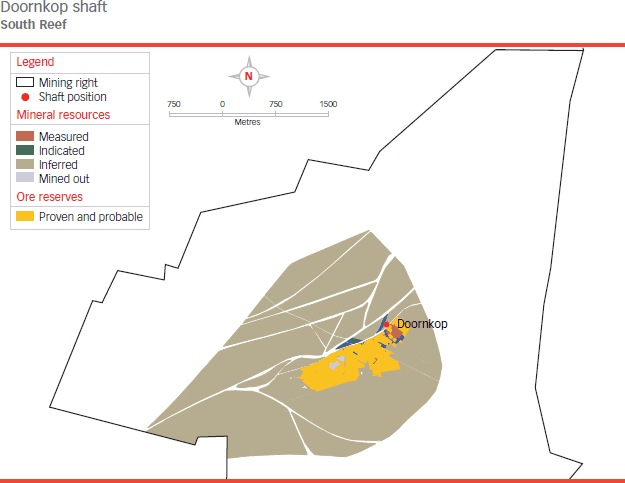Contents
- Corporate profile
- Key statistics 2009
- Key features 2009
- Operations at a glance
- FY09 – milestones
- Harmony strategy
- Chairman’s letter
- Chief executive officer’s review
- Review of operations
- Exploration overview
- Mineral resources and ore reserves
- Board of directors
- Executive management
- Corporate governance
- Directors’ report
- Report of the independent auditors (PDF - 37KB)
- Group annual financial statements (PDF - 312KB)
- Company annual financial statements (PDF - 123KB)
- Statement of subsidiary companies (PDF - 48KB)
- Investor relations
- Glossary of terms
- Administrative information
Doornkop
Geology: The structure of the West Rand goldfield is dominated by the Witpoortjie and Panvlakte Horst blocks, which are superimposed over broad folding associated with the south-east plunging West Rand syncline. At the Doornkop mine, both the Kimberley Reef and the South Reef are exploited.
The Doornkop shaft lease area is bounded by and lies to the south-east of the major north-easterly striking Roodepoort Fault, which dips to the south and constitutes the southern edge of the Witpoortjie Horst Block or Gap. This Horst Block is comprised of the stratigraphically older sediments of the West Rand Group, the overlying Central Rand Group sediments having been removed by erosion. A number of other faults, forming part of and lying southeast of the Roodepoort Fault, including the Saxon Fault, also constitute conspicuous structural breaks. A second major fault, the Doornkop Fault, which trends in an east west direction occurs towards the southern portion of the lease area. This fault dips to the south and has an up-throw to the north.
Nearly the entire upper Witwatersrand section is present in the lease area and therefore all the major zones are present, though due to the distance of the area from the fan head, the number of economic bands and their payability is limited. Eight of the well-known reefs are present in the area, but only the Kimberley Reef and South Reef are considered viable at this stage.
The resource is concentrated in the Kimberley and South Reefs. The Kimberley Reef is contained in the Vlakfontein Member of the Westonaria Formation. This reef, also known as the K9 Reef horizon, rests on an unconformity and is a complex multi-pulse conglomerate, which can be separated into four facies or cycles. All four cycles consist on average of an upper conglomerate and a lower quartzite. The characteristics of every cycle are area-dependent and the grades are variable within each cycle.
The South Reef is approximately 900 metres below the current Kimberley Reef mining, and between 7.5 and 60 metres above the Main Reef horizon. The hanging wall to the South Reef consists of siliceous quartzites with non-persistent bands of “blue-shot” grit and thin argillite partings. The footwall to the South Reef is a light coloured and fairly siliceous quartzite. Secondary conglomerate bands and stringers in the hanging wall and footwall of the South Reef may contain sporadic gold values.
The general strike of the reef is east-west, with a dip from 10 to 20 degrees. The orebody at Doornkop has a strike length of 4km and a width of 4 km from west to east.
![Doornkop location [Map]](i/doornkop_ops.gif)
![Cooke 1/Doornkop geological section looking west [Map]](i/doornkop_cooke1.gif)

![Doornkop shaft (Kimberley Reef) [Map]](i/doornkop_shaft_kimberley.gif)
Mineral resources
| Measured | Indicated | Inferred | Total | |||||||||||||
|---|---|---|---|---|---|---|---|---|---|---|---|---|---|---|---|---|
| Tonnes | Gold | Gold | Tonnes | Gold | Gold | Tonnes | Gold | Gold | Tonnes | Gold | Gold | |||||
| Operations | (Mt) | g/t | (000kg) | (000oz) | (Mt) | g/t | (000kg) | (000oz) | (Mt) | g/t | (000kg) | (000oz) | (Mt) | g/t | (000kg) | (000oz) |
| Underground | ||||||||||||||||
| Doornkop | ||||||||||||||||
| Kimberley Reef | 9.1 | 3.27 | 30 | 960 | 6.8 | 2.64 | 18 | 574 | 159.7 | 2.51 | 401 | 12 893 | 175.6 | 2.56 | 449 | 14.427 |
| South Reef | 0.6 | 5.99 | 3 | 113 | 1.3 | 6.23 | 8 | 265 | 22.5 | 8.63 | 197 | 6 239 | 24.4 | 8.44 | 205 | 6 617 |
| GRAND TOTAL | 9.7 | 3.43 | 33 | 1 073 | 8.1 | 3.23 | 26 | 839 | 182.2 | 3.27 | 595 | 19 132 | 200.0 | 3.27 | 654 | 21 044 |
Modifying factors
| Operations | MCF (%) | SW (cm) | MW (cm) | PRF (%) |
| Doornkop | ||||
| Kimberley Reef | 95 | 405 | 450 | 95 |
| South Reef | 75 | 124 | 140 | 95 |
- MCF = Mine call factor
- MW = Milling width
- SW = Stoping width
- PRF = Plant recovery factor
Ore reserves
| Proven | Probable | Total | ||||||||||
|---|---|---|---|---|---|---|---|---|---|---|---|---|
| Operations | Tonnes (Mt) |
Grade g/t | Gold (000kg) |
Gold (000oz) |
Tonnes (Mt) | Grade g/t |
Gold (000kg) |
Gold (000oz) | Tonnes (Mt) |
Grade g/t |
Gold (000kg) | Gold (000oz) |
| Underground | ||||||||||||
| Doornkop | ||||||||||||
| Kimberley Reef | 0.3 | 2.48 | 1 | 20 | 0.3 | 2.57 | 1 | 25 | 0.6 | 2.53 | 2 | 45 |
| South Reef | 0.4 | 4.30 | 2 | 50 | 0.9 | 4.27 | 4 | 128 | 1.3 | 4.28 | 6 | 178 |
| GRAND TOTAL | 0.7 | 3.55 | 3 | 70 | 1.2 | 3.85 | 5 | 153 | 1.9 | 3.75 | 8 | 22.3 |
![Doornkop Kimberley Reef: grade tonnage curve (measured and indicated resources) [graph]](i/doornkop_kimberley_tonnage.gif)
![Doornkop South Reef: grade tonnage curve (measured and indicated resources) [graph]](i/doornkop_south_tonnage.gif)

